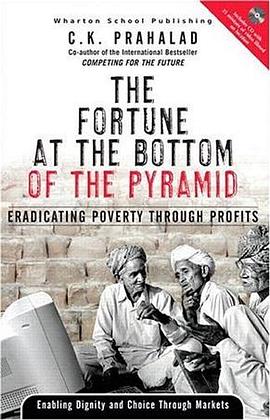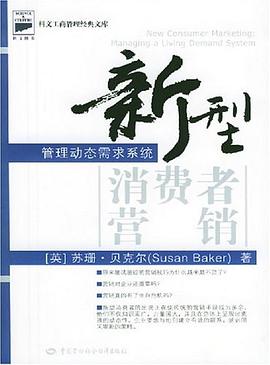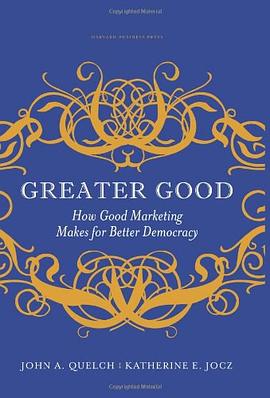
Preface Preface This book is a result of a long and lonely journey for me. It started during the Christmas vacation of 1995. During that period of celebration and good cheer, one issue kept nagging me: What are we doing about the poorest people around the world? Why is it that with all our technology, managerial know-how, and investment capacity, we are unable to make even a minor contribution to the problem of pervasive global poverty and disenfranchisement? Why can t we create inclusive capitalism? Needless to say, these are not new questions. However, as one who is familiar with both the developed and the developing world, the contrasts kept gnawing at me. It became clear that finding a solution to the problems of those at the bottom of the economic pyramid around the world should be an integral part of my next intellectual journey. It was also clear that we have to start with a new approach, a "clean sheet of paper." We have to learn from the successes and failures of the past; the promises made and not fulfilled. Doing more of the same, by refining the solutions of the past developmental aid, subsidies, governmental support, localized nongovernmental organization (NGO) based solutions, exclusive reliance on deregulation and privatization of public assets is important and has a role to play, but has not redressed the problem of poverty. Although NGOs worked tirelessly to promote local solutions and local entrepreneurship, the idea of large-scale entrepreneurship as a possible solution to poverty had not taken root. It appeared that many a politician, bureaucrat, and manager in large domestic and global firms agreed on one thing: The poor are wards of the state. This implicit agreement was bothersome. The large-scale private sector was only marginally involved in dealing with the problems of 80 percent of humanity. The natural question, therefore, was this: What if we mobilized the resources, scale, and scope of large firms to co-create solutions to the problems at the bottom of the pyramid (BOP), those 4 billion people who live on less than $2 a day? Why can t we mobilize the investment capacity of large firms with the knowledge and commitment of NGOs and the communities that need help? Why can t we co-create unique solutions? That was the beginning of my journey to understand and motivate large firms to imagine and act on their role in creating a more just and humane society by collaborating effectively with other institutions. It was obvious that managers can sustain their enthusiasm and commitment to activities only if they are grounded in good business practices. The four to five billion people at the BOP can help redefine what "good business practice" is. This was not about philanthropy and notions of corporate social responsibility. These initiatives can take the process of engagement between the poor and the large firm only so far. Great contributions can result from these initiatives, but these activities are unlikely to be fully integrated with the core activities of the firm. For sustaining energy, resources, and innovation, the BOP must become a key element of the central mission for large private-sector firms. The poor must become active, informed, and involved consumers. Poverty reduction can result from co-creating a market around the needs of the poor. We have to discard many of the "for and against" views of the world. For example, "are you for globalization or against it" is not a good question. Globalization, like all other major social movements, brings some good and some bad. Similarly, global versus local is not a useful debate. The tensions are real. Very early in my career, I learned that even within the multinational corporation (MNC) that is not a settled debate. Similarly, the debate between small (e.g., microfinance) and large (e.g., multinational firms) is not a useful debate either. Large business can bring efficiency. NGOs can bring creativity to solve the problems that face us all. Certainly, I wanted to avoid the paternalism towards the poor that I saw in NGOs, government agencies, and MNCs. This book is concerned about what works. This is not a debate about who is right. I am even less concerned about what may go wrong. Plenty can and has. I am focused on the potential for learning from the few experiments that are going right. These can show us the way forward. I do not want the poor of the world to become a constituency. I want poverty to be a problem that should be solved. This book is about all of the players NGOs, large domestic firms, MNCs, government agencies, and most importantly, the poor themselves coming together to solve very complex problems that we face as we enter the 21st century. The problem of poverty must force us to innovate, not claim "rights to impose our solutions." The starting point for this transition had to be twofold. First, we should consider the implications of the language we use. "Poverty alleviation" and "the poor" are terms that are loaded with meaning and historical baggage. The focus on entrepreneurial activities as an antidote to the current malaise must focus on an active, underserved consumer community and a potential for global growth in trade and prosperity as the four to five billion poor become part of a system of inclusive capitalism. We should commence talking about underserved consumers and markets. The process must start with respect for Bottom of Pyramid consumers as individuals. The process of co-creation assumes that consumers are equally important joint problem-solvers. Consumers and consumer communities will demand and get choice. This process of creating an involved and activist consumer is already emerging. The BOP provides an opportunity to turbocharge this process of change in the traditional relationship between the firm and the consumer. Second, we must recognize that the conversion of the BOP into an active market is essentially a developmental activity. It is not about serving an existing market more efficiently. New and creative approaches are needed to convert poverty into an opportunity for all concerned. That is the challenge. Once the basic approach was clear, the opportunities became obvious. The new viewpoint showed a different landscape and a focus on early and quiet attempts by some firms to explore this terrain. Unilever and its Indian subsidiary, Hindustan Lever Limited, was one such early experimenter. Around 1997, I found a kindred spirit in colleague Professor Stu Hart at the University of Michigan Business School (UMBS), who was approaching similar problems from a sustainable development perspective. We produced a working paper called "The Strategies for the Bottom of the Pyramid." Needless to say, not a single journal would accept the article for publication. It was too radical. Reviewers thought that it did not follow the work of developmental economists. Nobody noticed that we were offering an alternative to the traditional wisdom of how to alleviate global poverty. Thanks to the Web, various revisions of the working paper circulated freely. Surprisingly, a number of managers read it, accepted its premise, and started to initiate action based on it. Managers at Hewlett-Packard, DuPont, Monsanto, and other corporations started a venture fund and dedicated senior managers time and energy to examine this opportunity. Meanwhile, the Digital Dividend conference organized by Dr. Allen Hammond and the World Resources Institute in Seattle in 1999 provided a forum to examine these ideas in depth. I have not looked back. Since 1997, I have used every possible platform academic, managerial, and governmental to push the idea of the BOP as a market and a source of innovations. During the last five years, slowly at first but now more rapidly, a large number of NGOs, academics, and managers have started to discuss the need for an alternate approach to poverty alleviation and the potential role of the private sector and entrepreneurship as one of the critical elements. The publication of the two articles, "The Fortune at the Bottom of the Pyramid," in Strategy+Business (January 2002) with Stu Hart, and "Serve the World s Poor, Profitably" in the Harvard Business Review (September 2002) with Allen Hammond, facilitated the process of widespread discussion within corporations. Today, the discussion is not about "whether" but how fast and where. We have come a long way. In the fall of 2002, several MBA students at the UMBS came to me and said that they would like to work with me on BOP issues and that they were intrigued by the ideas they had seen in print as well as my message in numerous lectures on campus and outside. I was not easily convinced. I imposed extraordinary demands on them to convince me that they really cared. They convinced me overwhelmingly. They were ready to travel, explore opportunities, and endure the painful task of assembling convincing evidence. That was the start of the now widely accepted XMAP projects (a variant of International Multidisciplinary Action Projects IMAP, which UMBS has long supported with faculty mentoring.) The X in XMAP stood for experimental. The enthusiasm of the students, especially Cynthia Casas and Praveen Suthrum, provided the glue and helped see the project through administrative difficulties. I am grateful to all the MBA students whose dedication made this book possible. The book is in three parts. In Part I we develop a framework for the active engagement of the private sector at the BOP. It provides the basis for a profitable win win engagement. The focus is on the nature of changes that all players the large firm, NGOs, governmental agencies, and the poor themselves must accept to make this process work. Part II describes 12 cases, in a wide variety of businesses, where the BOP is becoming an active market and bringing benefits, far beyond just products, to consumers. The cases represent a wide variety of industries from retail, health, and financial services to agribusiness and government. They are located in Peru, Brazil, Nicaragua, Mexico, and India. They represent a wide variety of inst...
具体描述
读后感
我正在看的是这本书的日文版,因为上次去东京的时候一位关注社会企业的朋友力荐的。日文版还加了一个新的标题,叫做next market,封面也换成了类似MBA学校教材中的插页,大概是担心原来的两个印度老汉玩电脑的设计难以引起‘高端人士的注意’吧。 目前看了一个开头,很厚...
评分我正在看的是这本书的日文版,因为上次去东京的时候一位关注社会企业的朋友力荐的。日文版还加了一个新的标题,叫做next market,封面也换成了类似MBA学校教材中的插页,大概是担心原来的两个印度老汉玩电脑的设计难以引起‘高端人士的注意’吧。 目前看了一个开头,很厚...
评分我正在看的是这本书的日文版,因为上次去东京的时候一位关注社会企业的朋友力荐的。日文版还加了一个新的标题,叫做next market,封面也换成了类似MBA学校教材中的插页,大概是担心原来的两个印度老汉玩电脑的设计难以引起‘高端人士的注意’吧。 目前看了一个开头,很厚...
评分我正在看的是这本书的日文版,因为上次去东京的时候一位关注社会企业的朋友力荐的。日文版还加了一个新的标题,叫做next market,封面也换成了类似MBA学校教材中的插页,大概是担心原来的两个印度老汉玩电脑的设计难以引起‘高端人士的注意’吧。 目前看了一个开头,很厚...
评分我正在看的是这本书的日文版,因为上次去东京的时候一位关注社会企业的朋友力荐的。日文版还加了一个新的标题,叫做next market,封面也换成了类似MBA学校教材中的插页,大概是担心原来的两个印度老汉玩电脑的设计难以引起‘高端人士的注意’吧。 目前看了一个开头,很厚...
用户评价
其实只看了三分之二。反正I4H课也恶梦了,不想再看下去了。只是它论证了一个观点,挣钱和扶贫不是矛盾对立的,是可以双赢的
评分很有名的一本书。
评分刚买的,还没来得及读
评分还是原版的信息完整,中文版的翻译太烂了,略去了众多关键信息!
评分很有名的一本书。
相关图书
本站所有内容均为互联网搜索引擎提供的公开搜索信息,本站不存储任何数据与内容,任何内容与数据均与本站无关,如有需要请联系相关搜索引擎包括但不限于百度,google,bing,sogou 等
© 2025 qciss.net All Rights Reserved. 小哈图书下载中心 版权所有





















